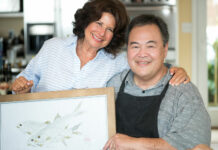By Diane Haynes Woodburn
 “I see it!” My husband, Jamie, is standing on our lanai, looking out through binoculars and talking on his cell phone. “It’s about a mile from shore.” This is the morning of the tsunami, and the Hawaiian Outrigger Canoe Voyaging Society’s canoe is missing, taken from its sandy resting place at the edge of an ancient fishpond by the early-morning tidal wave.
“I see it!” My husband, Jamie, is standing on our lanai, looking out through binoculars and talking on his cell phone. “It’s about a mile from shore.” This is the morning of the tsunami, and the Hawaiian Outrigger Canoe Voyaging Society’s canoe is missing, taken from its sandy resting place at the edge of an ancient fishpond by the early-morning tidal wave.
We had been the last passengers in the six-man canoe, having taken our mainland friends out for a Hawaiian experience just a few days before. With Kimokeo Kapahulehua as our steersman, we had headed out into crystal-clear water that offered sunlit views of coral heads, darting fish, and the occasional curious turtle poking his ancient-looking head up for a breath of air.
“E ala e,” Kimokeo began. “This is the chant of our ancestors,” he explained to our friends. “E ala e ka lai i ka hikina. Awake. The sun is in the East.” We joined in the chant, feeling the blessing of our island and our friendships. “Imua!” Paddling hard, we caught a wave. “Whoo-hoo!” I yelled with exhilaration as the ama, the outrigger, “flew,” raising itself out of the water as we sped to shore.
We walked to the fishpond, where Kimokeo told our friends about his work with volunteers young and old, from Maui and around the world, who are restoring the rock walls of this ancient aquaculture system. We each placed rocks of our own onto the wall, adding our small contribution to the strength of this handmade legacy.
“He’s heading right at it.” Jamie’s voice brings me back to the present. Already, a rescue boat is out looking for the canoe, and, Jamie confirms, closing in. I hear his deep sigh of relief; the vessel will be brought home. The tsunami was easy on Maui.
Not so in Japan. As the days pass, we learn the extent of the devastation, and so many lives lost. We grieve with them. At home, with no connection to the tsunami, we also grieve for more personal losses. In recent days, Hawai‘i has lost three great men, revered for their contributions to the community and to Hawaiian culture.
Akoni Akana was a kumu hula (hula teacher), a haku mele (composer of songs and chants), and as Rita Goldman notes in her article on Po‘okela, a founding member of the Friends of Moku‘ula and its mission to restore that ancient royal island.
Artist Herb Kawainui Kane is often called the father of the Hawaiian cultural renaissance. He helped found the Polynesian Voyaging Society, captained the Hokule‘a on her maiden voyage to Tahiti, and inspired a generation of Hawaiians to take pride in their heritage. We remember him on page 20.
Kendall Struxness, our dear friend, was a founding member of the Hawaiian Outrigger Canoe Voyaging Society, and one of four crewmembers to complete all six voyages to the Northwest Hawaiian Islands. Those historic voyages symbolically connected the entire 1,650 miles of the Hawaiian Archipelago, and for Kendall, became a spiritual pilgrimage. The film Imua documents the final 450-mile paddle to Kure Atoll, and will debut at the Maui Film Festival this June. Earlier voyages are archived in MNKO: Summer 2005, Jan/Feb 2007, and Nov/Dec 2008.
Akana, Kane and Kendall leave behind not only loving friends and a grateful community; they leave a legacy. Like the fishpond wall, their contributions hold fast, a foundation for those who come after. As this “Best of Maui” issue goes to press, I see clearly that the best is what we share with each other.
Rescued, the canoe awaits its next voyage—to carry Kendall’s ashes to sea, where his family and friends will commit him to the ocean he loved so much.
Aloha, Kendall. Fly the ama home.




